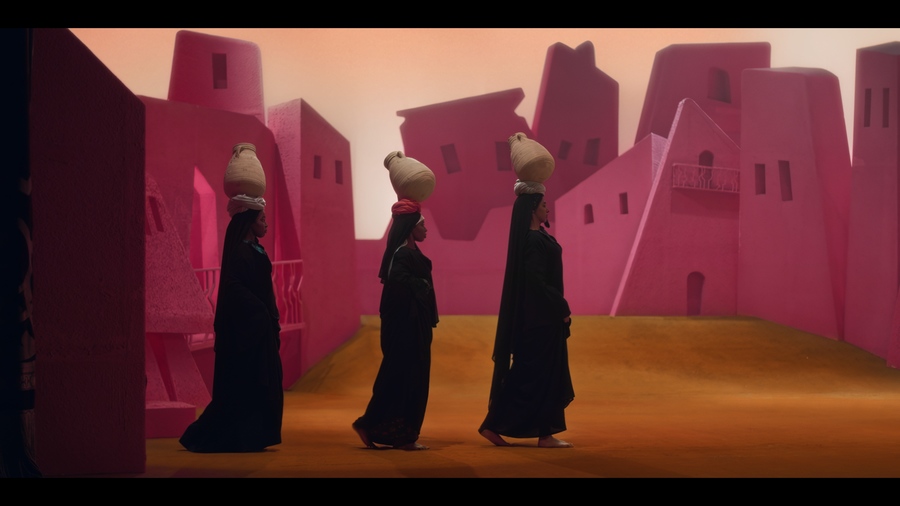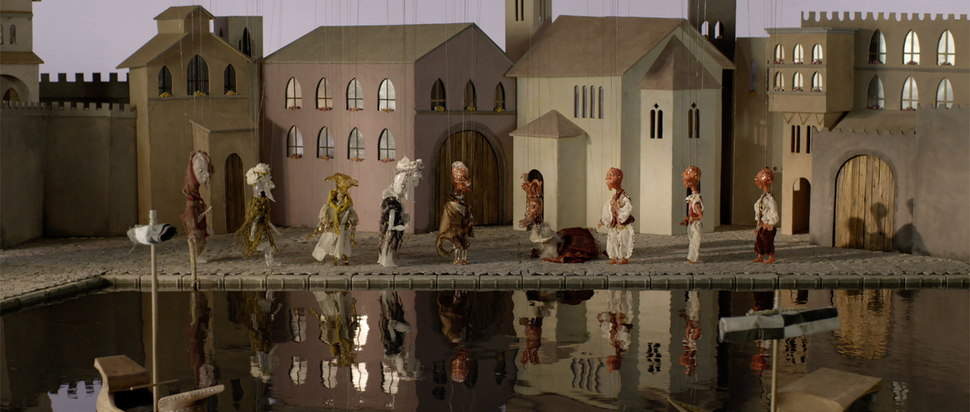The Spectacle of History: Wael Shawky @ Talbot Rice Gallery
Holly Allan, an Edinburgh Art Festival X The Skinny Emerging Writer, considers what it means to observe Wael Shawky’s solo exhibition in a city with a colonial past
On screen, a set of plush, red curtains open to reveal a dimly lit stage and we are positioned squarely in our new role: that of spectator. This is exactly where Wael Shawky wants us to be throughout all 48 minutes of his gripping opera film, Drama 1882. Using the vehicle of the play, the work asks us first and foremost to bear witness, as Shawky entangles us in a dance of spectatorship and complicity.
Showing as part of his solo show at Talbot Rice alongside his two hour epic Cabaret Crusades III: The Secrets of Karbala (2023), the exhibition aligns neatly with the gallery’s 50th anniversary; a fitting choice as Shawky’s work is rooted in the importance of histories and legacy. Created for the Egyptian Pavilion at the 60th Venice Biennale, Drama 1882 is a (re)telling of the crusades in Egypt and the role the British played in colonising the region in the 19th century.
While created for the global stage of the Biennale, Shawky’s work finds new resonance within the walls of Talbot Rice Gallery. A historical city with a colonial past, Edinburgh puts forth a new layer of context as the thematic exploration of power, corruption and complicity feel close to home in the gallery's grand halls, beckoning a heightened level of discomfort.
Shawky presents us with the artifice of theatre, allowing the story to extend out of the frame and into the Georgian gallery via the plush curtains which sheath the space, enshrining us in history and bringing the spectacle into the real world.

Still from Drama 1882 (2024) by Wael Shawky, Commissioned by Egyptian Ministry of Culture – Accademia d’Egitto © Wael Shawky. Courtesy of Lisson Gallery, Sfeir-Semler Gallery, Lia Rumma, and Barakat Contemporary.
Through dreamlike performance and a haunting libretto opera sung in classical Arabic, live actors recreate historical events; the Alexandria massacre, the Asitana Conference. A carousel of scheming generals and grieving women parade through Shawky’s intricate sets, exquisitely costumed and possessing a fantastical quality. This whimsy underscores the importance of histories being widely told lest they risk becoming subject to this fictionalised, dreamlike lens that Shawky glazes over his works as a warning.
The characters move stiffly, mechanically, like the figurines who march hourly through the tiny wooden doors on a cuckoo clock. Their rigid choreography complements Shawky’s enchanting, painted sets, often cartoonish in their flatness. They are brightly coloured in soft peaches, hot pinks, often with a crooked, angled quality reminiscent of 1920s German expressionist films and 1960s Loony Tunes. These evocations once again call into question reality and fantasy, history and myth; dichotomies that Shawky plays off one another. The dance of politics continues and the characters move in tandem, sunflower-like, as if manipulated by some invisible force.
This key theme of manipulation creeps through the rest of the exhibition as we see the exquisitely crafted Murano glass marionettes used in Cabaret Crusades III: The Secrets of Karbala. Their stilted movements on screen present a jarring, uncanny version of history which seeks to distance us from the story, turning fact into fiction, the everyday into the surreal. Hyper glossy and honey translucent, the marionettes are at once beautiful and grotesque, fantastical and alien. They are displayed in tiered rows beside their on-screen counterparts, offering us a peek behind the curtain. Dangling from the ceiling, their strings visible, Shawky gestures at the transference of control that comes from the top down, and the hierarchy of political puppets in power.
Although rooted in a distinct period and place, the truth-seeking present in Shawky’s work feels timeless, his recreation of the past shines a light on the present. Through our position as spectator, we begin to draw parallels with these reenactments and our contemporary world, noting the cyclical and predictable nature of history. Using the language of fantasy, Shawky coaxes us to reconsider our own relationship with history, both in the past but also as it is being made today. His films stand as cautionary tales, folkloric and foreshadowing, as the violence on screen parallels the bloodshed that persists today.
As the curtain closes on Drama 1882, the arrangement of characters sway softly, turning side to side as if suffering a mechanical glitch. They are poised, there is seemingly no repose, like they are winding themselves up, ready for tomorrow's matinee performance as history repeats itself.
Wael Shawky, Talbot Rice Gallery, until 28 Sep; part of Edinburgh Art Festival
Presented in association with Edinburgh International Festival
